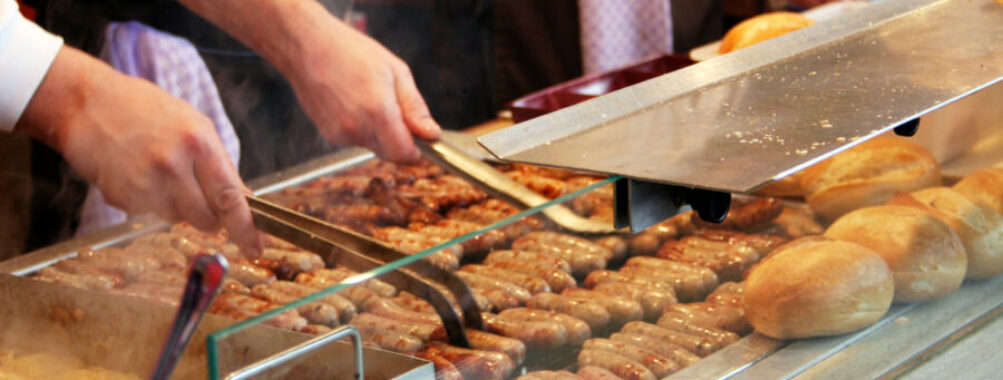
Traditional German Food: 22 Must-Try Authentic Dishes and Recipes
German cuisine often gets overlooked in conversations about European food, overshadowed by its French and Italian neighbors. But Germany’s rich, hearty dishes offer some of the world’s most satisfying comfort food experiences. From the crispy perfection of schnitzel to the tangy delight of sauerkraut, traditional German food combines simple ingredients with time-honored techniques to create dishes that have sustained generations.
In this comprehensive guide, you’ll discover authentic German dishes that showcase the diversity and deliciousness of Deutsche Küche. Whether you’re planning a trip to Germany, looking to connect with your German heritage, or simply want to expand your culinary horizons, these must-try specialties will give you a true taste of Germany’s rich food traditions.
Contents
- The Rich History of German Cuisine
- 22 Must-Try German Dishes
- Main Dishes
- Sausages
- Potato Dishes
- Side Dishes & Soups
- Desserts & Sweets
- Frequently Asked Questions About German Food
- What is the national dish of Germany?
- What should people know before trying German food?
- Exploring German Cuisine At Home
- More Travel Guides
The Rich History of German Cuisine

German food history reflects the country’s central European geography and agricultural traditions. While modern Germany only unified in 1871, German-speaking regions share culinary traditions dating back centuries. The cuisine developed around locally available ingredients: abundant pork, hearty grains, root vegetables (especially potatoes), and preserved foods designed to last through harsh winters.
Regional variations emerged based on local resources and cultural influences:
- Northern Germany: Seafood-focused cuisine influenced by Scandinavian neighbors
- Bavaria and Southern Germany: Hearty meat dishes with Austrian and Swiss influences
- Western Germany: Wine-region cuisine with French-inspired techniques
- Eastern Germany: Dishes showing Slavic influences from neighboring countries
Despite these regional differences, certain principles unite German cooking: practicality, seasonality, and minimal waste. Traditional German food makes use of every part of an animal, preserves seasonal abundance through pickling and smoking, and transforms simple ingredients into satisfying meals.
22 Must-Try German Dishes
Main Dishes
1. Sauerbraten (German Pot Roast)

Often called Germany’s national dish, Sauerbraten (literally “sour roast”) represents German cooking’s pinnacle. This pot roast is marinated in a vinegar-based mixture for several days before slow cooking. The extended marination tenderizes tougher cuts of meat while infusing deep flavor.
What makes Sauerbraten special is its distinctive sweet-sour gravy, often thickened with crushed gingersnap cookies (Lebkuchen) for a subtly spiced finish. Traditionally served with red cabbage and potato dumplings, Sauerbraten exemplifies the German talent for transforming simple ingredients into complex flavors.
2. Schnitzel (Breaded Cutlet)
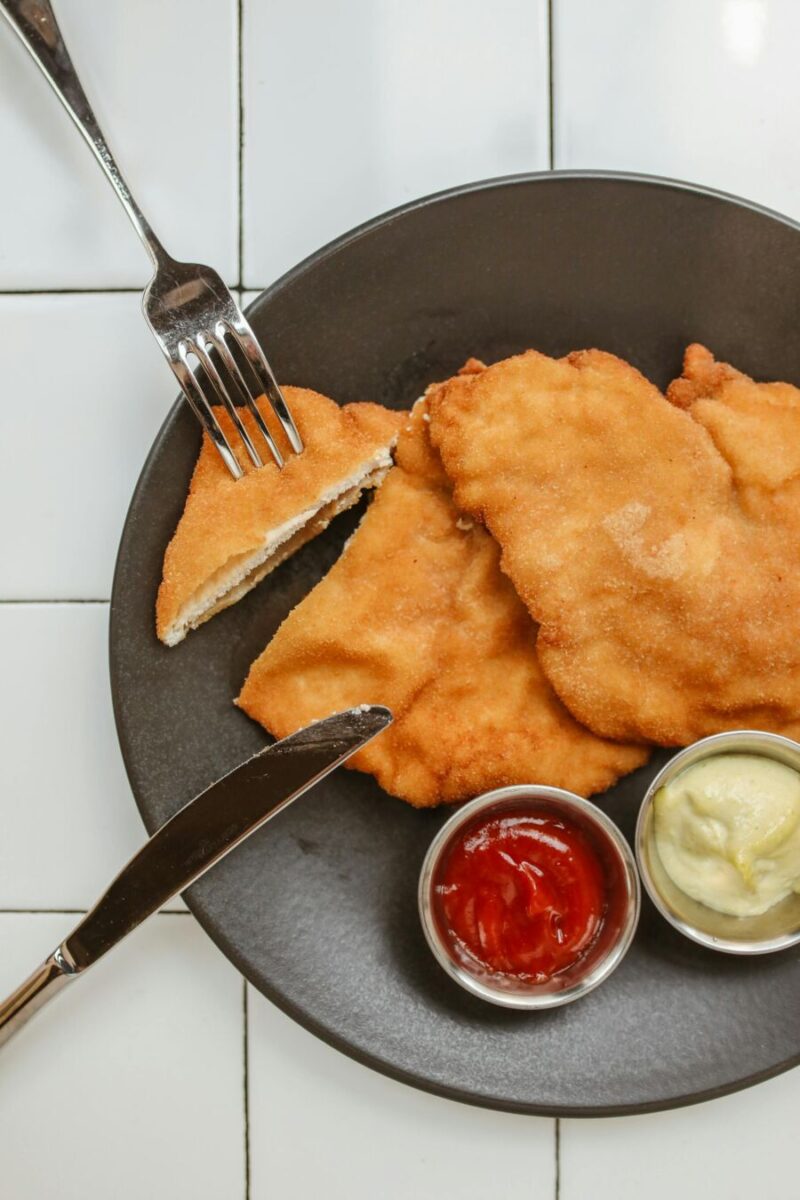
Perhaps Germany’s most internationally recognized dish, schnitzel consists of thinly pounded meat (traditionally veal, though pork is now more common) that’s breaded and fried to golden perfection. The most famous variation is Jägerschnitzel (hunter’s schnitzel), topped with a rich mushroom gravy.
To make authentic schnitzel, the meat must be pounded very thin, which tenderizes it and ensures quick, even cooking. The breading process – flour, egg, breadcrumbs – creates the characteristic crispy exterior that Germans prize. A squeeze of fresh lemon juice before serving brightens the flavor of this beloved dish.
Recipe: Classic German Schnitzel
Ingredients:
- 4 boneless pork chops (about 5-6 oz each)
- ½ cup all-purpose flour
- 2 large eggs, beaten
- 1½ cups plain breadcrumbs
- Salt and pepper to taste
- ½ cup vegetable oil for frying
- Lemon wedges for serving
Instructions:
- Place pork chops between plastic wrap and pound to ¼-inch thickness
- Season both sides with salt and pepper
- Set up breading station: flour in one dish, beaten eggs in second dish, breadcrumbs in third dish
- Dredge each cutlet in flour, shake off excess
- Dip in egg, letting excess drip off
- Coat in breadcrumbs, pressing gently to adhere
- Heat oil in a large skillet over medium-high heat
- Fry schnitzel 2-3 minutes per side until golden brown and crispy
- Drain on paper towels
- Serve immediately with lemon wedges
3. Rouladen (Beef Rolls)

These thin slices of beef wrapped around a savory filling epitomize German Sunday dinners and special occasions. Traditional Rouladen filling includes mustard, bacon, onions, and pickle spears, though regional variations exist throughout Germany.
The rolled beef is secured with string or toothpicks, then seared and braised in a rich gravy until fork-tender. The long, slow cooking develops deep flavors, making this dish well worth the effort. Rouladen is almost always served with potato dumplings or boiled potatoes to soak up the delicious sauce.
4. Schweinshaxe (Pork Knuckle)
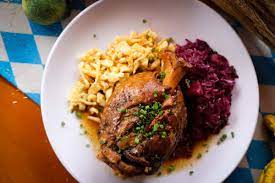
A Bavarian specialty, Schweinshaxe is a roasted ham hock (pork knuckle) featuring crispy crackling skin and meltingly tender meat. This imposing dish is a staple at Oktoberfest celebrations and traditional beer halls throughout southern Germany.
Preparation involves slow-roasting the pork knuckle until the meat nearly falls off the bone while the skin transforms into crackling perfection. The natural collagen in this cut breaks down during cooking, creating a self-basting effect that results in incredibly juicy meat. Traditionally served with sauerkraut and potato dumplings, Schweinshaxe pairs perfectly with a cold German beer.
5. Königsberger Klopse (Meatballs in Caper Sauce)

Named after the former East Prussian capital (now Kaliningrad, Russia), these delicate veal and beef meatballs simmer in a creamy white sauce flavored with capers, lemon, and sometimes anchovy. Unlike Italian meatballs, Königsberger Klopse include soaked bread, anchovy, and sometimes herring, creating a distinctly Northern German flavor profile.
The creamy white sauce, made from a roux with added capers and lemon juice, is reminiscent of a classic French béchamel but with decidedly Baltic influences. This dish illustrates the historical connection between German and Eastern European cuisines. Typically served with boiled potatoes and beetroot, Königsberger Klopse remains a beloved comfort food throughout Germany despite its origins in a region that is no longer German territory.
6. Eintopf (German Stew)
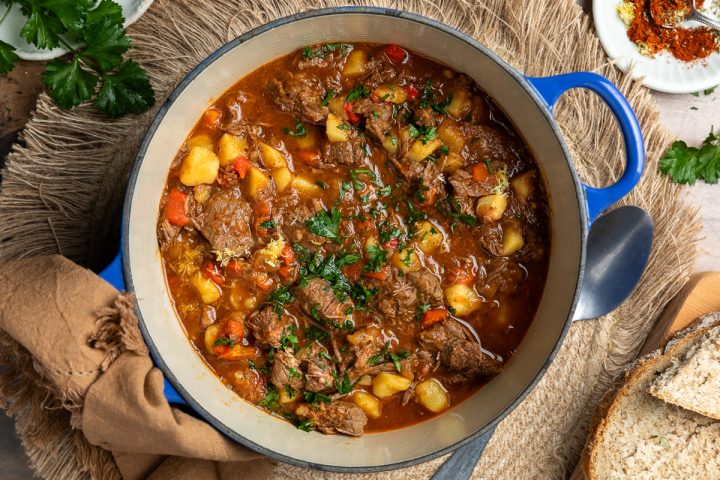
The name Eintopf literally means “one pot,” describing this versatile, hearty German stew. Rather than a single recipe, Eintopf represents a cooking method where meat, vegetables, potatoes, and sometimes legumes simmer together in one pot, creating a complete meal.
Regional variations abound, from the bean-heavy Westphalian Blindhuhn to the Frankfurt green sauce version with seven specific herbs. What unites all Eintopf recipes is their practicality and satisfying nature. During difficult economic times, particularly between the World Wars, Eintopf became a symbol of German resilience—a way to create nourishing meals from whatever ingredients were available.
7. Kasseler (Smoked Pork Chop)
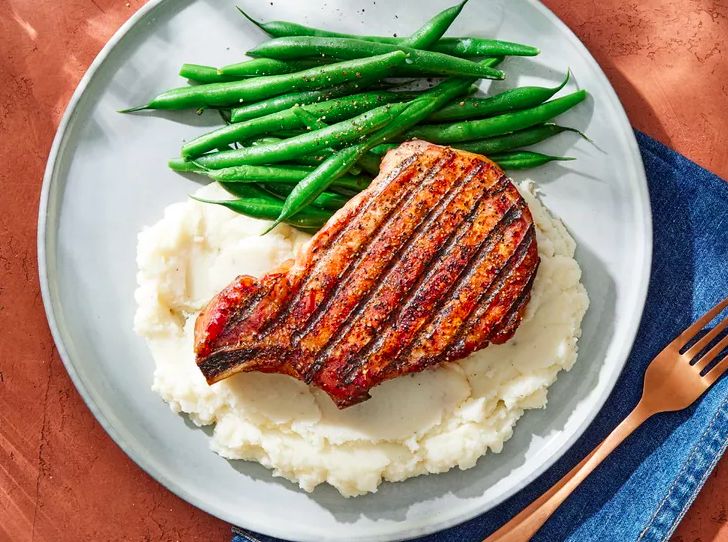
Kasseler (or Kassler) features cured and smoked pork loin or neck, creating a distinctive flavor somewhere between fresh pork and ham. This specialty originated in Berlin in the 19th century, supposedly invented by a butcher named Cassel.
The meat is brined and lightly smoked, then typically pan-fried or roasted until juicy and tender. The smoking process gives Kasseler its characteristic pink hue and provides flavor without requiring long cooking times. It’s often served with sauerkraut, mashed potatoes, or kale, and makes a quick yet satisfying weeknight meal in many German households.
8. Labskaus (Northern German Corned Beef Hash)
This distinctive Northern German sailor’s dish might not win beauty contests, but its flavor and history make it a must-try. Originating in the port cities of Hamburg and Bremen, Labskaus was created as a practical meal for sailors using preserved ingredients available on long voyages.
Traditional Labskaus combines corned beef, onions, potatoes, and beetroot, all mashed together into a distinctive purplish mixture. It’s typically served with fried egg, pickled herring (Rollmops), and pickles. The unusual appearance often surprises first-timers, but the savory, earthy, and tangy flavor reveals why this humble dish has endured for centuries along Germany’s northern coast.
Sausages
9. Bratwurst (Grilled Sausage)
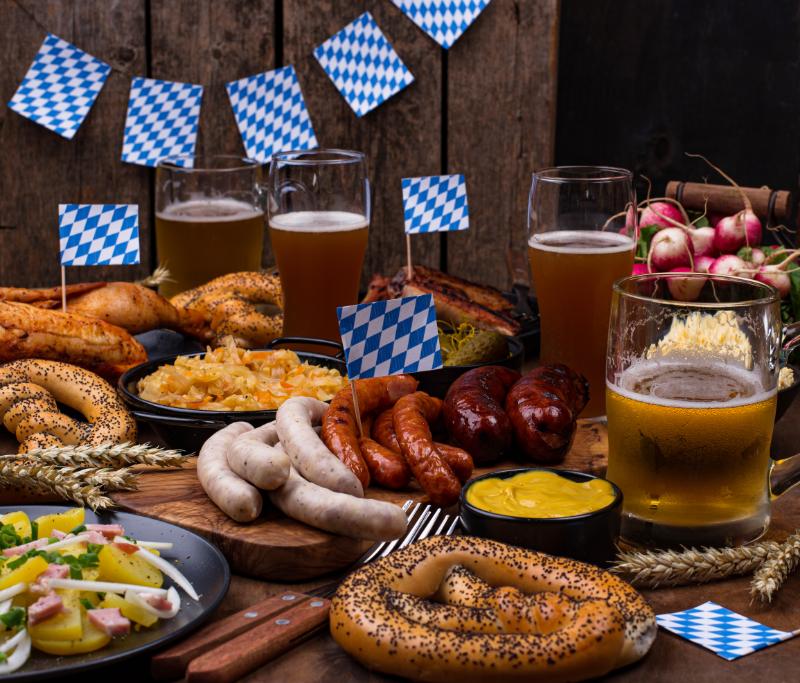
The quintessential German sausage, Bratwurst is a fresh sausage typically made from pork (though veal and beef variations exist) and flavored with a blend of spices that might include marjoram, nutmeg, caraway, or garlic. The name comes from “brät” (finely chopped meat) and “wurst” (sausage).
Each German region proudly makes its own variation—Nuremberg’s finger-sized Rostbratwurst, Thuringia’s herb-infused version, and the coarser-textured varieties from the Rhineland. Traditionally grilled over beechwood for a distinctive smoky flavor, Bratwurst is typically served with mustard, sauerkraut, or potato salad, and is a staple at German festivals and street markets.
10. Weisswurst (Bavarian White Sausage)
This distinctive pale sausage is a Bavarian specialty with its own set of traditions. Made from finely minced veal and pork back bacon, Weisswurst is gently spiced with parsley, lemon, mace, onions, ginger, and cardamom. Its delicate flavor and color come from the absence of preservatives that would darken the meat.
According to Bavarian tradition, Weisswurst should be eaten before noon (“the sausage should not hear the church bells ring at noon”) because it was historically made without preservatives. Served in a bowl of hot water to keep warm, the proper way to eat Weisswurst is to cut the end and suck the meat from the casing or carefully remove the casing before eating. The only appropriate condiment is sweet Bavarian mustard, accompanied by a pretzel and wheat beer.
11. Currywurst (Sausage with Curry Sauce)
A Berlin street food icon born in the post-WWII era, Currywurst represents German culinary innovation during challenging times. The dish consists of steamed then fried pork sausage, sliced and topped with a curry-spiced ketchup sauce, then dusted with curry powder.
Legend credits Herta Heuwer with inventing Currywurst in 1949, when she obtained ketchup and curry powder from British soldiers and combined them to create a new sauce for sausages. Today, Germans consume about 800 million Currywurst annually, and Berlin even has a museum dedicated to this humble street food. The dish perfectly demonstrates how global influences have shaped contemporary German cuisine.
12. Blutwurst (Blood Sausage)
Reflecting the German tradition of utilizing every part of the animal, Blutwurst is made by combining congealed pig’s blood with diced fat, onions, and spices like marjoram, thyme, and cloves. The mixture is then stuffed into casings and smoked or cooked. Regional variations include the famous Rheinische Blutwurst from the Rhineland and Thüringer Blutwurst with its distinctive marjoram flavor.
Blutwurst can be served cold on bread, pan-fried with apples and onions, or included in hearty dishes like “Himmel und Erde” (Heaven and Earth), which combines blood sausage with potatoes (from the earth) and apples (from heaven). While the concept might challenge some international diners, blood sausage is an important part of Germany’s nose-to-tail butchery tradition.
Potato Dishes
13. Kartoffelsalat (German Potato Salad)

Unlike the mayonnaise-heavy American version, traditional German potato salad showcases regional differences that highlight Germany’s diverse culinary traditions. Southern German/Bavarian style is served warm with a vinegar-based dressing, bacon, and fresh herbs, while Northern German style is made with mayonnaise, apple pieces, and pickles, typically served cold.
The Bavarian-style potato salad exemplifies the German preference for letting simple ingredients shine. Red potatoes are boiled until just tender, then sliced while still warm and immediately dressed so they absorb maximum flavor. The tangy dressing—vinegar, mustard, onion, and warm bacon fat—creates a perfect accompaniment to rich meat dishes or sausages.
Recipe: Bavarian Potato Salad
Ingredients:
- 2 lbs red potatoes
- 6 slices bacon, diced
- 1 medium onion, finely chopped
- ¼ cup white vinegar
- 2 tbsp whole grain mustard
- 2 tbsp fresh parsley, chopped
- Salt and pepper to taste
Instructions:
- Boil potatoes in salted water until fork-tender (about 15-20 minutes)
- Meanwhile, cook bacon in a skillet until crispy
- Remove bacon, leaving fat in the pan
- Sauté onions in bacon fat until translucent
- Add vinegar and mustard to the pan, simmer briefly
- Slice warm potatoes into ¼-inch rounds
- Pour hot dressing over potatoes
- Add bacon and parsley, gently toss
- Season with salt and pepper
- Serve warm or at room temperature
14. Kartoffelpuffer (Potato Pancakes)
Known by different regional names (Reibekuchen, Reiberdatschi, or Kartoffelpuffer), potato pancakes are beloved across Germany. These crispy treats consist of grated raw potatoes mixed with egg, onion, and flour, then fried until golden.
In the Rhineland, potato pancakes are often served with applesauce, while other regions prefer them with sour cream or as a side dish to savory meals. During Christmas markets, you’ll find them sold as popular street food, perfect for warming cold hands and filling hungry stomachs.
The key to authentic potato pancakes lies in removing excess moisture from the potato mixture before frying, which ensures crispiness. Many German home cooks insist on hand-grating the potatoes rather than using food processors, claiming it produces a superior texture.
15. Kartoffelklöße (Potato Dumplings)
These hearty dumplings come in numerous regional variations, but all serve the essential purpose of soaking up delicious gravies and sauces from meat dishes. The two main types are Thuringian dumplings (made from a mixture of raw and cooked potatoes) and Bavarian dumplings (typically made from cooked, mashed potatoes).
A traditional preparation includes a crouton or bread cube center that adds textural contrast to the soft dumpling. When sliced open, this surprise center delights diners and helps distinguish a well-made dumpling. Potato dumplings require skill to prepare correctly—too much moisture results in disintegration during cooking, while too little creates dense, heavy dumplings. This makes them a test of a cook’s abilities and a source of family pride in many German households.
Side Dishes & Soups
16. Rotkohl (Braised Red Cabbage)
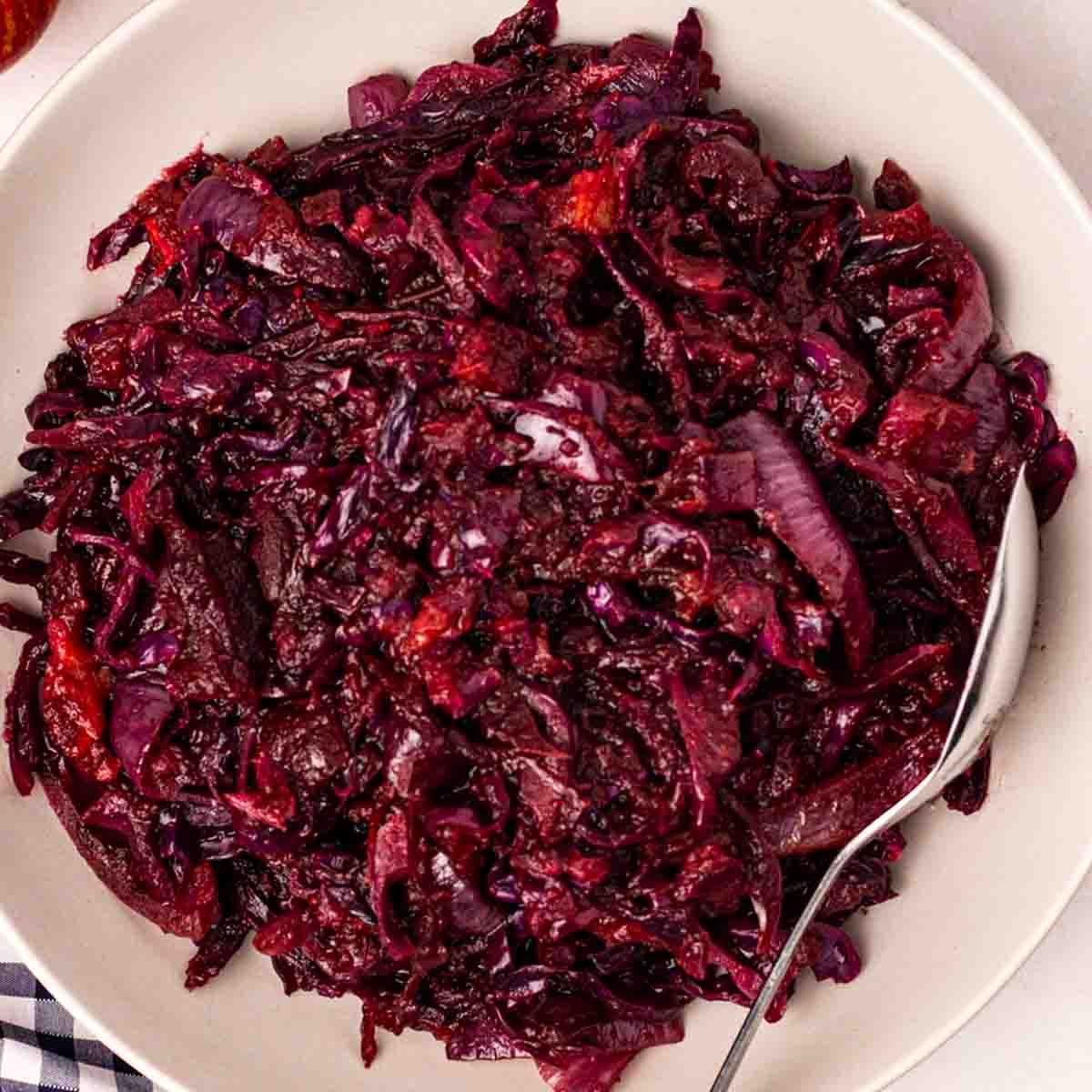
One of Germany’s most beloved side dishes, red cabbage is slowly braised with apples, onions, and spices until meltingly tender. The deep purple-blue vegetable transforms during cooking, developing complex flavors that balance sweet, sour, and spicy notes.
Traditional recipes include tart apples for natural sweetness, vinegar for acidity, warming spices like cloves and bay leaves, and sometimes red wine for depth. Red cabbage pairs perfectly with game meats, roast pork, and duck, cutting through richness with its tangy-sweet profile. Germans often prepare it in large batches, as the flavors improve over several days of refrigeration. In many families, Sunday roasts aren’t complete without this colorful side dish.
Recipe: Classic German Braised Red Cabbage
Ingredients:
- 1 medium red cabbage (about 2 lbs), thinly sliced
- 2 tart apples, peeled and diced
- 1 large onion, thinly sliced
- 3 tbsp butter
- 3 tbsp apple cider vinegar
- 2 tbsp sugar
- 1 cup water or red wine
- 2 bay leaves
- 3 whole cloves
- 5 juniper berries (optional)
- Salt and pepper to taste
Instructions:
- Melt butter in a large Dutch oven over medium heat
- Add onions and sauté until translucent (about 5 minutes)
- Add cabbage and apples, stir to coat with butter
- Pour in vinegar, water/wine, and add sugar and spices
- Bring to a simmer, cover, and reduce heat to low
- Cook for 1-1.5 hours, stirring occasionally, until cabbage is tender
- Season with salt and pepper to taste
- Remove bay leaves, cloves, and juniper berries before serving
17. Sauerkraut (Fermented Cabbage)
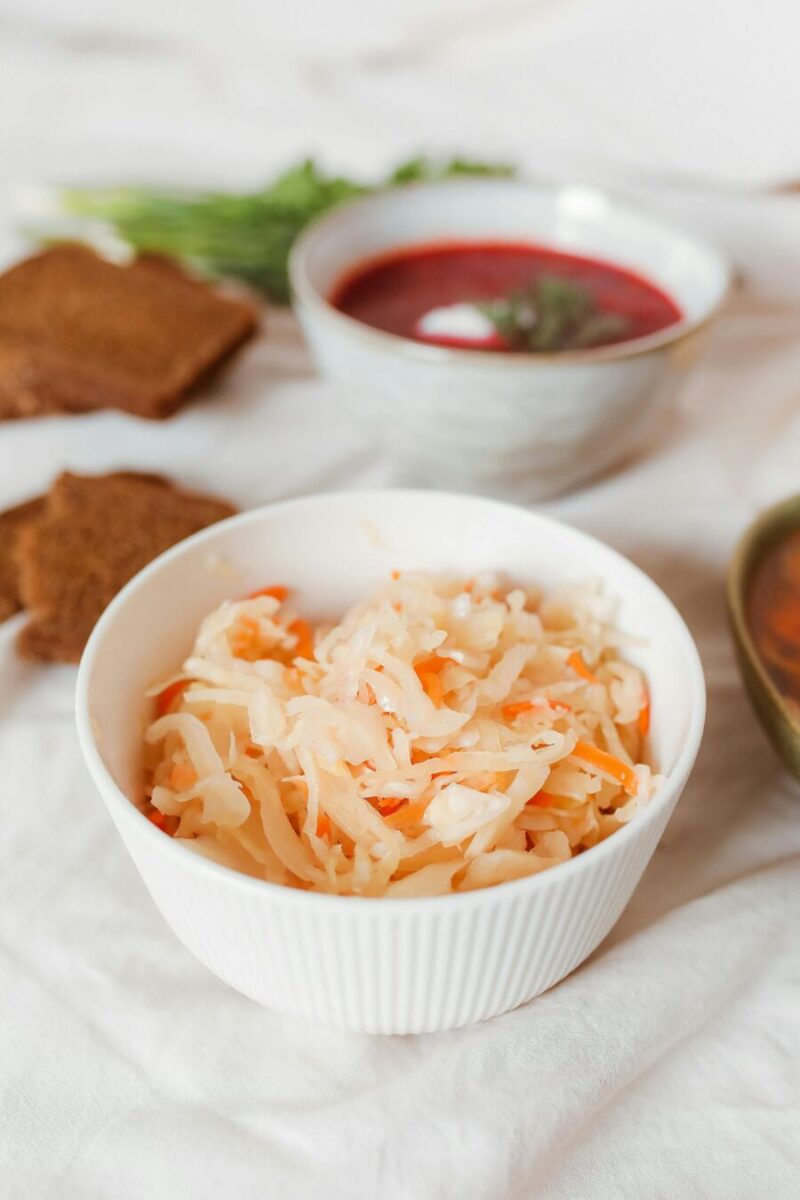
Perhaps Germany’s most famous vegetable preparation, sauerkraut consists of finely shredded cabbage fermented with salt. This ancient preservation method not only extends cabbage’s shelf life but also creates a probiotic-rich food with a distinctive tangy flavor.
Traditional German households often had a dedicated crock for fermenting sauerkraut, especially in regions where harsh winters limited fresh produce availability. Today, while many Germans purchase commercially prepared sauerkraut, artisanal and homemade versions are experiencing a revival among those interested in traditional food practices.
Germans typically cook sauerkraut rather than eating it raw, simmering it with aromatics like juniper berries, caraway seeds, and apples to mellow its acidity. Classic pairings include Kasseler (smoked pork chop), various sausages especially Frankfurters, pork roast, and Schupfnudeln (finger-shaped potato dumplings).
18. Käsespätzle (Cheese Noodles)
Often described as German mac and cheese, Käsespätzle combines handmade egg noodles (Spätzle) with layers of melted cheese and caramelized onions. This comfort food originates from Swabia in southwestern Germany, where it’s considered a regional specialty.
The noodles themselves require skill to make—a soft dough of flour, eggs, and water is pushed through a Spätzle maker or colander directly into boiling water, creating irregular, rustic noodles. After draining, the hot Spätzle are layered with grated mountain cheese (typically Emmentaler or Gruyère) and topped with crispy fried onions. The residual heat melts the cheese into gooey perfection.
Käsespätzle is typically served in earthenware dishes, straight from the oven, with a green salad to balance the richness. In Alpine regions, the dish might include crispy bacon or chives. This hearty vegetarian option demonstrates that meat isn’t always the centerpiece of German meals.
Desserts & Sweets
19. Schwarzwälder Kirschtorte (Black Forest Cake)

Arguably Germany’s most famous dessert internationally, authentic Black Forest cake comes from the southwestern region of the same name. This sophisticated torte features layers of chocolate sponge cake, whipped cream, and sour cherries, with a distinctive kick from kirsch (cherry schnapps).
The origins of this iconic cake trace back to the early 20th century, though cherries, chocolate, and cream had been regional specialties for much longer. What makes a true Black Forest cake special is the balance between rich chocolate, tart cherries, and creamy, not-too-sweet whipped cream. The kirsch adds complexity rather than sweetness, creating a sophisticated dessert that’s festive yet refined.
Many bakeries outside Germany create simplified versions that miss the authentic character of this classic. A genuine Schwarzwälder Kirschtorte should have distinct layers, visible cherries, and a noticeable (but not overwhelming) presence of kirsch.
20. Apfelstrudel (Apple Strudel)

While often associated with Austria, apple strudel enjoys enormous popularity throughout Germany, especially in Bavaria. This delicate pastry features paper-thin dough stretched until nearly transparent, then wrapped around a filling of sliced apples, sugar, cinnamon, raisins, and sometimes nuts.
The magic of strudel lies in its contrasting textures: the shattering crisp exterior giving way to tender, juicy apple filling. Traditional preparation requires skill, with the dough stretched by hand until thin enough to read a newspaper through it. Home bakers today might use phyllo dough as a shortcut, though purists insist the results aren’t comparable.
Serve apple strudel warm with a dusting of powdered sugar and a side of vanilla sauce (similar to thin custard) or vanilla ice cream for an authentic experience.
21. Lebkuchen (German Gingerbread)

These spiced cookies, especially associated with Christmas, have a history dating back to medieval monasteries. Nuremberg’s version (Nürnberger Lebkuchen) enjoys protected geographical status, requiring specific ingredients and production methods.
Unlike crisp gingerbread cookies from other traditions, German Lebkuchen tends to be soft and cakey, with a complex spice profile including cinnamon, cloves, anise, cardamom, and coriander. Traditional recipes incorporate nuts (often almonds and hazelnuts), candied citrus peel, and honey.
During German Christmas markets, you’ll find elaborately decorated Lebkuchen hearts (Lebkuchenherzen) hung from ribbons, bearing sweet messages or holiday greetings—a charming edible souvenir that embodies German festive traditions.
22. Bienenstich (Bee Sting Cake)

This classic German cake features a yeast dough base topped with honey-glazed almonds and filled with a rich vanilla custard cream. The name (“bee sting”) supposedly comes from a legend about bakers who were attacked by bees attracted to the sweet honey topping while making this cake.
What makes Bienenstich special is its textural contrast: the fluffy yeast cake, crunchy caramelized almond topping, and smooth vanilla cream create a perfect trinity of textures. The honey in the topping adds a distinctive floral note that distinguishes it from other cream cakes.
Traditionally served at afternoon coffee, Bienenstich represents the German passion for Kaffee und Kuchen (coffee and cake), a social tradition similar to British tea time. The cake is best enjoyed fresh on the day it’s made, when the contrast between the crisp topping and soft filling is at its peak.
Frequently Asked Questions About German Food
What is the national dish of Germany?
Germany doesn’t have an official national dish, but Sauerbraten (dish #1 in our list) is often considered the unofficial national dish due to its historical significance and widespread popularity throughout German regions.
What should people know before trying German food?
To fully appreciate German cuisine:
- Embrace regional specialties – Food varies dramatically between regions; what’s common in Bavaria might be rare in Hamburg.
- Understand meal structure – Traditional German meals include:
- Breakfast (Frühstück): Bread, cold cuts, cheese, and boiled eggs
- Lunch (Mittagessen): Traditionally the largest meal
- Coffee and cake (Kaffee und Kuchen): Afternoon social tradition
- Dinner (Abendessen): Often cold meats, cheese, and bread (“Abendbrot”)
- Appreciate bread culture – Germany boasts hundreds of bread varieties, and quality matters deeply to Germans.
- Be open to sweet-sour combinations – Many dishes balance these flavors in ways unfamiliar to other cuisines.
- Try local beers and wines – German regions pride themselves on local beverages that pair perfectly with regional specialties.
Exploring German Cuisine At Home
Now that you’ve discovered these 22 authentic German dishes, you might be eager to recreate some of them in your own kitchen. While some traditional preparations like Sauerbraten require time and planning, many German specialties are surprisingly accessible for home cooks.
Start with these approachable dishes from our list:
- Kartoffelsalat (#13) – The vinegar-based dressing makes this lighter than American versions
- Schnitzel (#2) – Even cooking beginners can master this simple preparation technique
- Rotkohl (#16) – Improves with time, making it perfect for meal prep
- Kartoffelpuffer (#14) – These potato pancakes make a versatile side dish or snack
- Apfelstrudel (#20) – Using store-bought phyllo dough simplifies this classic dessert
As you explore German cooking, remember that authenticity comes not just from following recipes exactly, but from understanding the spirit behind them—practical techniques that transform simple ingredients into deeply satisfying meals meant to be shared with others.
The next time you’re looking for comfort food that satisfies both body and soul, consider turning to Germany’s rich culinary heritage. From hearty stews that warm winter evenings to fresh salads that celebrate summer’s bounty, these 22 German specialties offer something for every season and occasion. Guten Appetit!




Nancy Burris
I grew up with a German family, my Oma taught me about backing and hearty meals, I miss those days when we made stollen for Xmas 🥰